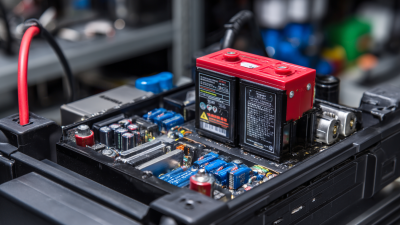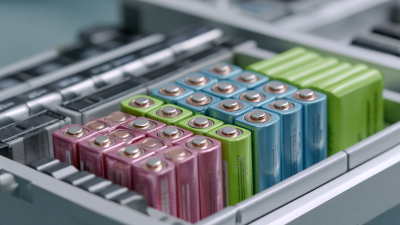Top 10 Benefits of Using Rechargeable Batteries for Sustainable Power Solutions
The increasing awareness of environmental sustainability has catalyzed a significant shift in consumer behavior, particularly regarding energy consumption. In a world where electronic devices are ubiquitous, the shift towards using battery rechargeable solutions has become paramount. According to a report from the International Energy Agency (IEA), rechargeable batteries accounted for over 35% of the total battery market in 2021, a figure that is projected to increase as advancements in technology improve their efficiency and affordability. This trend not only underscores the growing reliance on portable power sources but also highlights the essential role rechargeable batteries play in reducing electronic waste.

Furthermore, a study by the United Nations found that single-use batteries contribute significantly to battery waste, estimated to be over 3 million tons annually. By contrast, the use of battery rechargeable systems can mitigate this issue, offering both economic and ecological advantages. Rechargeable batteries can be reused hundreds of times, thus not only lowering the demand for new raw materials but also minimizing the environmental footprint associated with battery production and disposal. As we delve into the top ten benefits of rechargeable batteries, it becomes evident that opting for these sustainable power solutions is not just a choice for conservation but a significant step towards a greener future.
Advantages of Reduced Environmental Impact with Rechargeable Batteries
Rechargeable batteries are revolutionizing our approach to sustainable power solutions, significantly reducing our ecological footprint. Unlike their disposable counterparts, which contribute to an abundance of waste in landfills, rechargeable batteries can be reused hundreds of times, minimizing waste generation. This longevity not only curtails the need for frequent replacements but also decreases the carbon emissions associated with manufacturing and transporting new batteries. Additionally, many rechargeable batteries are designed with recyclable components, further enhancing their environmentally-friendly profile.
Tip: When purchasing rechargeable batteries, consider investing in a high-quality charger that can help extend the life of your batteries. A good charger can condition the batteries, ensuring they are fully charged without overcharging, which can diminish their capacity over time.
The ease of recycling rechargeable batteries also fosters a more sustainable approach to energy consumption. Many retailers and manufacturers offer robust recycling programs, allowing consumers to return used batteries easily. By participating in these programs, individuals contribute to a circular economy, where materials are reused and waste is minimized, aligning perfectly with the growing emphasis on sustainability.
Tip: Always check for local recycling options before disposing of any batteries. Many communities have specific collection days or designated drop-off sites that ensure batteries are disposed of safely, preventing environmental contamination.
Top 10 Benefits of Using Rechargeable Batteries for Sustainable Power Solutions
| Benefit | Description | Environmental Impact | Long-term Cost Savings |
|---|---|---|---|
| Reduced Waste | Rechargeable batteries can be used multiple times, significantly decreasing the amount of waste produced. | Minimizes landfill overflow and pollution. | Reduces costs compared to single-use batteries over time. |
| Energy Efficiency | Rechargeable batteries typically have a higher energy efficiency than standard batteries. | Lower energy consumption results in reduced carbon footprint. | More effective use of energy resources leads to cost savings. |
| Lower Toxicity | Many rechargeable batteries contain fewer toxic materials than disposable batteries. | Decreases risk of hazardous waste affecting soil and water. | Potential healthcare cost savings due to lower pollution. |
| Versatility | Available in various sizes and types for different applications. | Encourages the use of sustainable power across multiple devices. | Cost-effective for powering diverse devices. |
| Longer Lifespan | Rechargeable batteries have a longer usable life compared to standard batteries. | Reduction in the frequency of battery disposal. | Lower replacement costs over time. |
| Faster Charging | Modern rechargeable batteries offer rapid charging capabilities. | Improves efficiency and reduces waiting time, promoting usage. | Increased productivity leading to indirect savings. |
| Cost-Effectiveness | While the initial investment may be higher, the long-term use offers financial benefits. | Encourages sustainable practices, saving money and the environment. | Saves money on frequent battery purchases. |
| Greater Availability | Rechargeable batteries are widely available in stores and online. | Facilitates the transition to sustainable energy sources. | Easier access leads to more consistent use and savings. |
| Support for Renewable Energy | Rechargeable batteries can store energy from renewable sources. | Helps reduce reliance on fossil fuels. | Potentially lower energy costs with renewable energy use. |
| Enhanced Performance | Many rechargeable batteries provide a consistent output over time. | Reduces waste caused by performance degradation. | Improves efficiency leading to cost reductions in energy use. |
Cost Efficiency of Rechargeable Batteries Over Their Lifespan
Rechargeable batteries are becoming increasingly popular as a sustainable power solution, primarily due to their impressive cost efficiency over time. According to a report from the Battery University, while traditional alkaline batteries can cost around $0.50 each and need frequent replacement, a single rechargeable nickel-metal hydride (NiMH) battery can be used over 500 times, with an average cost of about $2.00 per charge cycle. This means that over their lifespan, rechargeable batteries can save consumers significantly on both battery purchases and disposal costs.
Moreover, a study published by the International Energy Agency (IEA) indicates that shifting to rechargeable batteries can lead to savings of approximately $1.5 billion annually in the U.S. alone by reducing reliance on disposable batteries. When considering the costs associated with the manufacturing and disposal of traditional batteries—often linked to environmental hazards—the financial benefits of rechargeable alternatives become even clearer. Investing in rechargeable batteries not only supports a more sustainable future but also offers substantial long-term savings for households and businesses alike.
Enhanced Performance and Power Output Compared to Single-Use Batteries
Rechargeable batteries have rapidly gained popularity as a sustainable power solution, primarily due to their enhanced performance and power output compared to single-use batteries. One significant advantage is that they often deliver a higher energy density, meaning they can store more energy in the same amount of space. This feature is particularly beneficial for high-drain devices like digital cameras and portable gaming systems, where prolonged operation without frequent replacements is essential. The ability to recharge these batteries also means fewer interruptions in usage, enhancing overall convenience.
In addition to their superior energy output, rechargeable batteries generally exhibit a more stable voltage during discharge. This stability translates to better performance in electronic devices, ensuring they operate at optimal levels throughout their use. Furthermore, with advancements in battery technology, such as lithium-ion and nickel-metal hydride options, these batteries also charge faster while maintaining their power efficiency. This combination of features underscores the growing preference for rechargeable batteries, not only for environmental sustainability but also for the enhanced performance they provide over their single-use counterparts.

The Role of Rechargeable Batteries in Advancing Renewable Energy Solutions
Rechargeable batteries play a pivotal role in advancing renewable energy solutions, significantly impacting the efficiency and sustainability of energy storage systems. According to a report by the International Renewable Energy Agency (IRENA), the global capacity of rechargeable batteries is expected to reach 300 GWh by 2030, underscoring their crucial involvement in integrating renewable energy sources such as solar and wind into the power grid. By enabling better energy management, these batteries help mitigate the intermittent nature of renewable energy, ensuring a more reliable supply.

Furthermore, research by the U.S. Department of Energy highlights that the adoption of rechargeable battery technology can lead to a reduction of greenhouse gas emissions by up to 80% in comparison to traditional fossil fuel counterparts. This drastic decrease is particularly relevant in applications like electric vehicles and home energy storage systems, which allow users to harness solar power during the day and use stored energy at night. As society continues to shift towards greener energy solutions, the role of rechargeable batteries will become increasingly vital in supporting a sustainable and resilient energy future.
Promoting Circular Economy Through Increased Use of Rechargeable Battery Technologies
The increasing adoption of rechargeable battery technologies plays a significant role in promoting a circular economy. By utilizing rechargeable batteries, consumers are able to minimize waste and reduce reliance on single-use batteries, which often end up in landfills. This shift not only conserves resources but also empowers users to take an active part in reducing environmental impact. As rechargeable batteries can be used multiple times, they represent an investment in both durability and sustainability.
In line with this growing trend, the global battery management system (BMS) market is projected to expand from $11.42 billion in 2024 to $46.94 billion by 2032, reflecting a robust compound annual growth rate (CAGR) of 19.32%. This surge illustrates the increasing importance of effective energy management and the need for technologies that support the efficient use of rechargeable batteries in various applications, including electric vehicles and renewable energy systems. The transition towards employing rechargeable batteries not only drives market growth but also aligns seamlessly with global efforts aimed at enhancing sustainability and fostering a circular economy.
Top 10 Benefits of Using Rechargeable Batteries for Sustainable Power Solutions
Related Posts
-

Transform Your Yard: The Ultimate Guide to Choosing the Right Lawn Battery for Your Needs
-

Innovative Solutions for Emergency Light Battery Maintenance You Should Know
-

Unlocking the Benefits: Why Rechargeable Sealed Lead Acid Batteries Are the Future of Power Storage
-

Unveiling Battery Acid Innovations at the 2025 China Import and Export Fair
-

Essential Guide to Choosing the Right Lawn Tractor Battery for Optimal Performance
-

Unleashing the Power: Exploring the Future of Eco-Friendly Batteries & More Innovations
